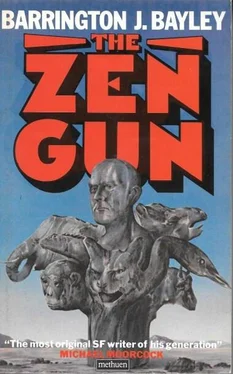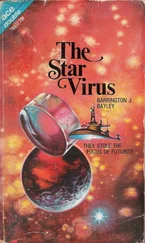“And then we’re going to rape Diadem,” Morgan finished for him.
“That’s right. The greatest act of pillage in history. It will be just like taking some ripe, defenceless woman—Diadem doesn’t have any defences of its own. There are only the Star Force fleets, and they are out in the Empire.”
“They could soon be recalled,” Drue pointed out.
“Too late. It will be a stand-off: we give them the message, move in and we start blasting worlds.”
“And if they promise the same for Escoria?” Tengu asked softly.
Ragshok’s answer was a ferocious growl. “We let them! What’s it to us? The Empire will fall to pieces and we pick up Diadem as first prize.”
He stood up, pointing to Tengu. “You and Morgan see to the reconnoitre. I’ll round up our team leaders and organise the squads.”
Just then an odd, transient event took place. In the air before him Ragshok seemed to see fine silvery threads, straight as tracks of light and sparkling from end of the restaurant to the other. It was like a linear cobweb being spun just too fast for the eye to catch. But in a second or two the apparition was gone.
“What in the Simplex was that? ” he demanded.
When, in the ballroom aboard Standard Bearer , Archier noticed similar threads, this time glinting obliquely from floor to ceiling, he took them for an arranged visual effect, a presage to some extravagance to come. Then word was brought to him. Something unexplained was happening.
He summoned Arctus and made his way to the Command Centre. On the way there they saw the threads again. This time they started at the farther end of the corridor and proceeded at moderate pace down it, looking, he thought, like an array of lines marking the interfaces of metallic crystals. But, before they reached him, they vanished.
In the Command centre he found the white-haired Menshek and a number of ship engineers, including the chief engineer he had questioned earlier over the behaviour of Earth’s moon. Menshek was talking earnestly with the duty officer, a young tiger.
With a spasm of guilt at having such a thought, Archier suddenly found himself wishing some of the engineers could have been human. Animals weren’t at their best when handling the totally unknown.
“These lines that are appearing in the air,” Menshek said to him. “We’re getting the same reports from all over the fleet. In fact we think they’re appearing over a wide region of space. It must be another manifestation from the rent.”
“The instruments showed a very brief interruption in the operation of the engines,” the gorilla chief engineer told him. “That could be serious. But it hasn’t recurred yet.”
“We’re not supposed to be in the affected region yet,” Archier remarked.
“It’s probably spread.”
“Are we close to any stars?”
“Yes sir,” the duty officer informed him gruffly. “We are about to sidestep a system with an inhabited planet, as a matter of fact. We’ll pass within three light-days.”
“We’d best make for it. Our investigation can start there. Decelerate and alter course.”
While the tiger obeyed, quietly speaking instructions, the cobweb lines reappeared. Archier could see now that they emerged from the walls. They gave him the impression of being immensely, immensely long—light-years, at least.
They vanished. “What do you make of it?” Archer asked Menshek. He paused. “Could they be something to do with recession lines?”
“Nothing in our universe could make recession lines visible,” Menshek pointed out. “But did you ever watch Cursom’s book on what other facets might be like? Purely speculative, of course, but the point is they might not consist of three-dimensional realms containing particulate matter, like ours. The ‘flattening’ or collapse of the Simplex might take other forms, well-nigh incomprehensible to our intellects. Specifically, Cursom predicts there will be facets where it’s the recession lines, not the particles they connect, that become the ‘material entities’, while the original particles would play the part of separating locations or end-points. The fundamental unit of such a facet would not be a pointlike particle but a sort of extensible line, no limit being placed on length. Such lines, infinitesimal in themselves, would be able to collect themselves together to form the equivalent of higher structures—atoms, molecules and so forth—but always strictly in parallel. The threads we have seen answer to that description. They might even be living forms.”
“Linear matter,” Archier pondered, while the animals stared, struggling to comprehend. “But could it exist in our kind of space?”
“Perhaps, once it arrived here. Or perhaps their space and ours is intermingling.”
“And if they are intelligent, how would they see us?”
“Ah, that’s a question,” Menshek seemed to find the question intriguing. Briefly he turned to watch the data form in the air as the Fleet Manoeuvres Department did its work. “They would lack our sense of individuality as something existing at a defined place—indeed, they would scarcely understand the notion of ‘place’ as we do. Their equivalent of a single particle might sometimes extend throughout the whole of their spacetime, and it would be the same for larger structures. For them, the concept of ‘being’ would be associated with linear dispersal.
“They might not, yet, have been able to find anything here they can recognise as having material properties.”
Archier sighed fretfully. “I wish Diadem could have sent us a scientist! We’re out of our depth!”
“Have you tried to find any among the passengers?” Menshek asked. “Passengers” was how Star Force crews referred to the inevitable hangers-on aboard ships of the fleets.
“I did put the word out, but you know how reluctant these people are to get involved in anything.”
“Perhaps you should have made it clear what’s involved.”
Archier shook his head. “There’s state security to think of.”
The conversation was interrupted by a sound of tumult from the outside. Snarling softly, the duty officer whirled round as through the door there burst a shouting group of what Archier, because they still wore costume, the bellicose images rearing above those who were human, presumed at first were revellers who had inconsiderately intruded into the working area.
But they were clearly terrified. A lissom-figured young woman, her senile face set into the belly of a writhing, evil-looking Mother Kali, rushed up to him, her woe-begone expression an incongruous contrast.
“Admiral!” she screamed. “They’re coming through the intermats! They’re killing everybody!”
Archier tried to free himself of the clutching arms of both herself and her costume.
“Who?”
“Rebels! Pirates! I don’t know!”
Shucking off its silvery-grey covering that vaguely resembled a feetol shell, an impala trotted up to Archier to paw him nervously. “Savages, Admiral, savages! Do you know what they’re wearing? Animal skins! Do you hear me? Animal skins! ”
The impala’s voice broke on a hysterical note.
“Call commando quarters,” Archier ordered the duty officer. “If you find any troops there, tell them to arm themselves. When you’ve done that, check with the rest of the fleet. I’ll go and look into this.”
He ran from the Command Centre and back down the broad passageway that led towards the ballroom. But he soon stopped, his blood freezing. Spilling down the corridor, fleeing from the salon, came a panicking mob, a jostling forest of screaming, multicoloured shapes.
Trying to give himself time to think, he pressed himself against the wall as the crowd surged by. How could this horror have come about? Through the intermats , she had said. And the kiosks in the salon were only one of several sets throughout the big battleship. But how could rebels have gained access to the intermat facility?
Читать дальше












